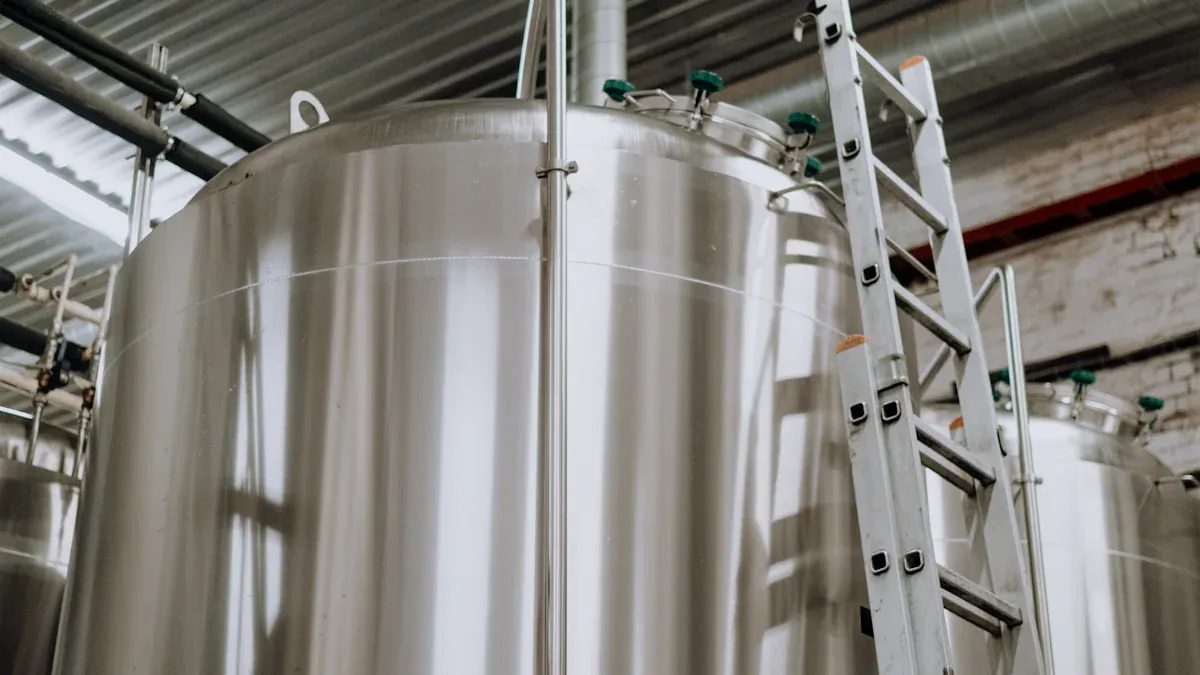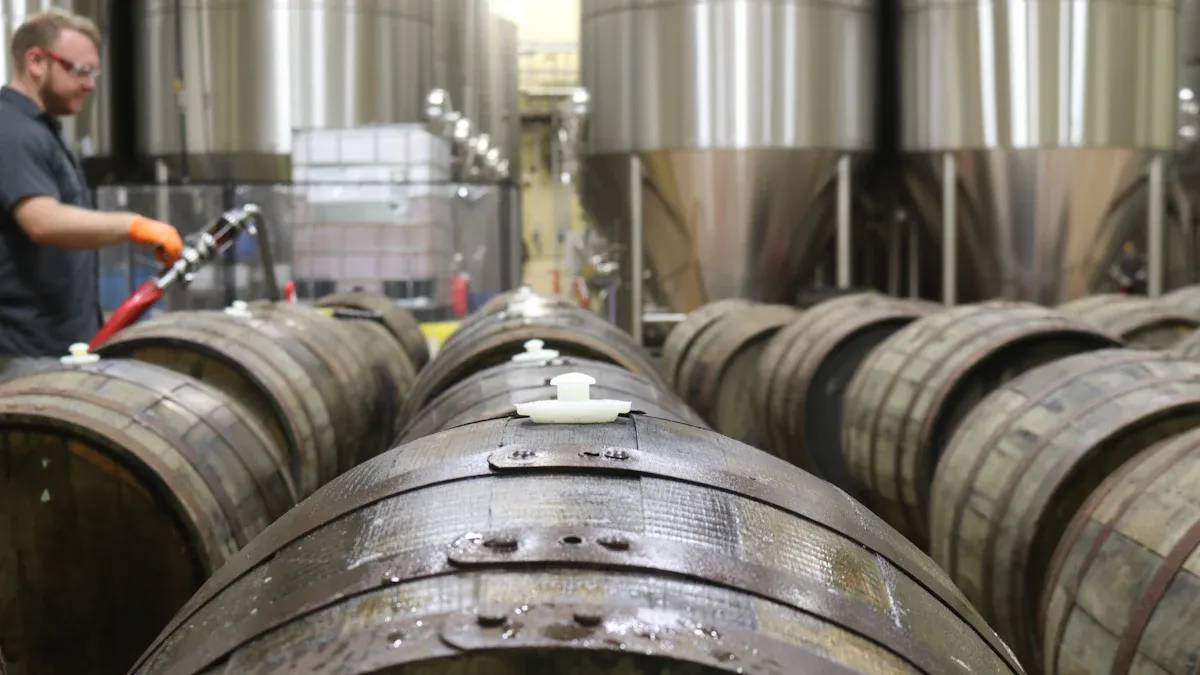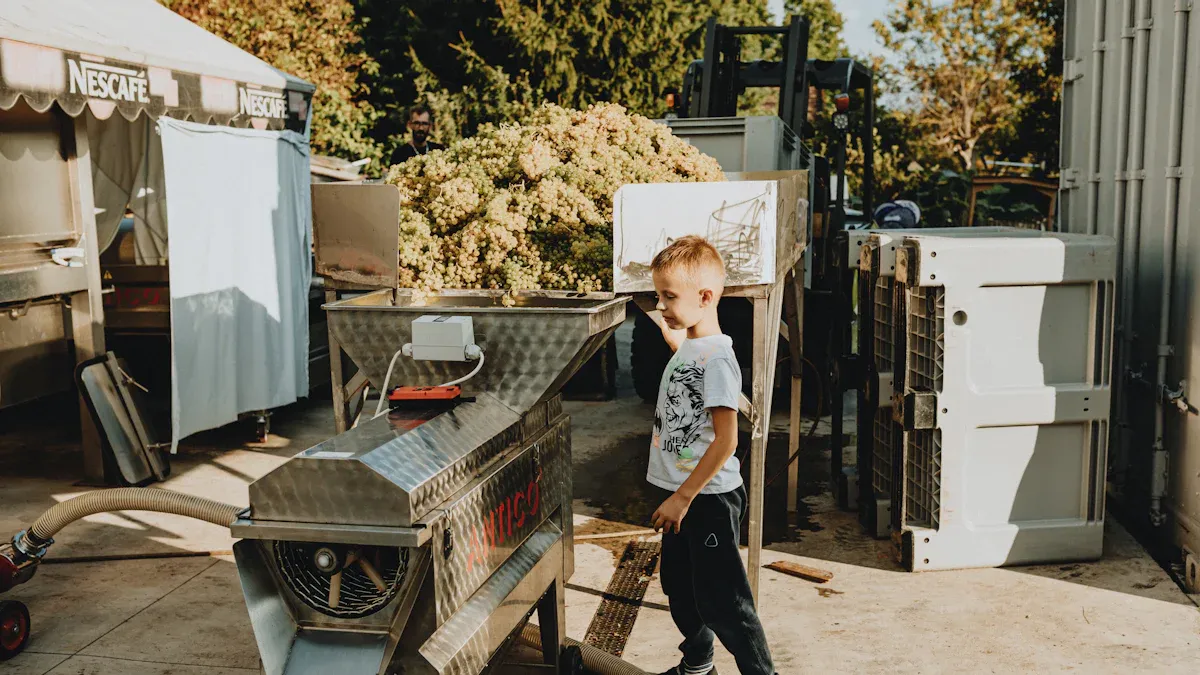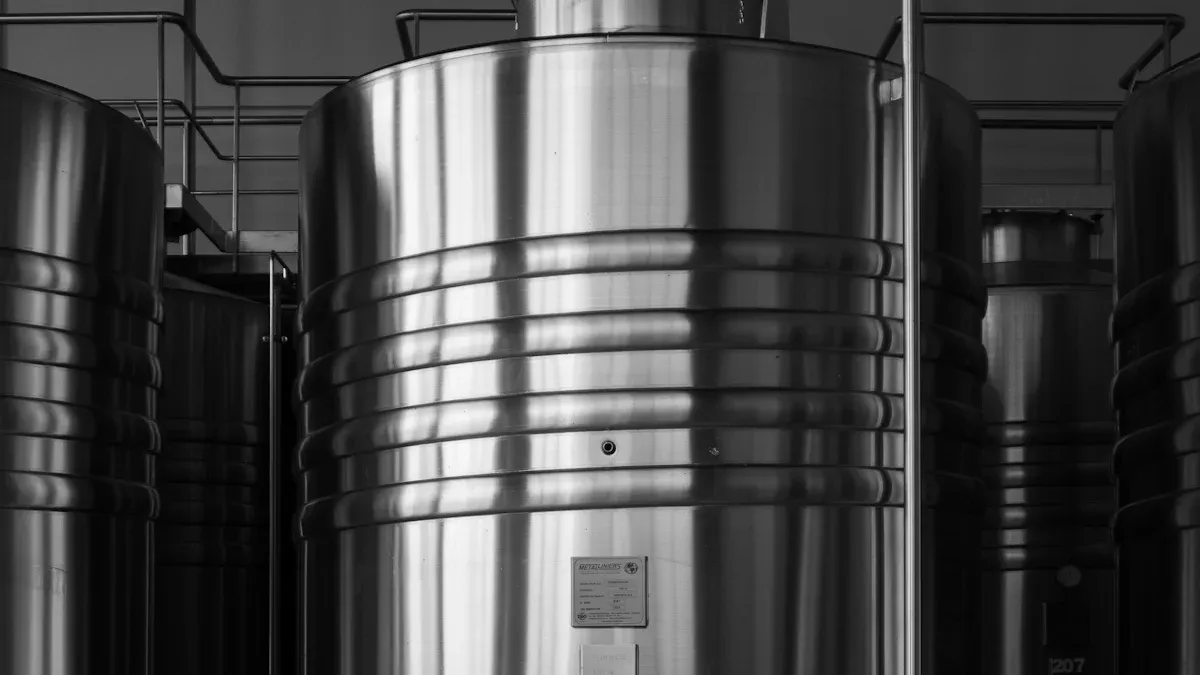
Wine fermentation tank dimensions shape much more than just your cellar’s layout. The size and shape of each tank influence wine quality, energy use, and even your bottom line. Small and large wineries often face different hurdles, from balancing cost with production needs to managing maintenance and energy consumption. Many wineries also consider environmental impact, monitoring needs, and installation costs when choosing a tank. Chenma’s custom solutions help you get the right fit, which can reduce risks and maximize the benefits for your wine.
Fermentation and Tank Dimensions

Temperature Control
Temperature control is one of the most important factors during primary fermentation. The size and shape of your wine fermentation tank play a big role in how well you can manage heat. When you use a small tank, you get a higher surface area compared to the volume. This means heat escapes faster, and the temperature stays more even. In large tanks, heat builds up in certain areas, especially near the top where the grape skins form a cap. Studies show that in big tanks, the temperature can be much higher in the cap than in the liquid below. Sometimes, the difference can reach up to 10°C. This uneven heat can change how fast fermentation happens and affect the taste of your wine.
You can use cap management techniques like pump-overs or punch-downs to help mix the wine and even out the temperature. The shape of the tank also matters. Tall, narrow tanks lose heat faster than short, wide ones. The way you place cooling jackets and sensors on the tank helps you control the temperature better. If you want to keep your wine at the right temperature, you need a tank that matches your batch size and your cooling system.
Tip: Choosing the right wine fermentation tank dimensions helps you save energy. Smaller tanks cool down faster and use less power. Larger tanks need stronger cooling systems to keep the temperature steady during primary fermentation.
Chenma offers custom wine fermentation tanks with advanced features to help you manage temperature. These tanks use Dimple Plate Cooling Jackets for even cooling. They are made from stainless steel 304/316L, which keeps the tank strong and helps control heat. Chenma tanks come in many sizes, from 500L to 50,000L, so you can pick the best one for your winery. Each tank passes strict tests and comes with a 3-year warranty on temperature control parts. You also get support for different electrical systems, making it easy to use the tanks anywhere in the world.
Wine Quality
The quality of your wine depends on many things, but temperature control during fermentation is key. If the temperature gets too high, yeast can die or work too fast, which changes the flavors in your wine. If the temperature is too low, fermentation slows down, and you might get stuck fermentation. The right wine fermentation tank helps you avoid these problems.
Scientific studies show that tank dimensions do not always change the final wine quality by themselves. Instead, the way you control temperature, oxygen, and mixing during primary fermentation makes a bigger difference. For example, two tanks with similar shapes can produce different wines if one gets hotter during fermentation. The tank that keeps a steady temperature will usually make better wine.
When you use a wine fermentation tank with good temperature control, you get more consistent results. You can keep the yeast happy and make sure the flavors develop the way you want. Chenma’s tanks help you do this by giving you precise control over the fermentation process. You can adjust the cooling system to match your needs, whether you are making a small batch or a large one.
Note: Good tank design supports natural mixing inside the tank. This keeps the yeast spread out and helps the temperature stay even. You get a smoother fermentation and better wine in the end.
Choosing the right wine fermentation tank dimensions is not just about fitting the tank in your space. It is about making sure you can control the temperature, manage energy use, and get the best wine possible from every batch.
Wine Fermentation Tank Design
Aspect Ratio
The shape of your wine fermentation tank matters as much as its size. The aspect ratio, or the height-to-width relationship, changes how your wine develops during primary fermentation and aging. A tall, narrow tank gives you a different result than a short, wide one. You can use different aspect ratios to control oxygen exposure, mixing, and contact with grape skins or lees.
Many wineries adjust tank shapes to reach specific goals:
- Some winemakers use large oak puncheons for Syrah and Grenache. These big barrels lower the surface area to liquid ratio, which reduces oak flavor and lets the vineyard character shine.
- Others choose cigar-shaped barrels for Viognier. This shape slows oxygen movement and increases contact with lees, making the wine rounder.
- At Long Shadows, winemakers ferment Merlot in very large upright oak tanks. This boosts color and mouthfeel by controlling oxygen and tannin integration.
- Some use egg-shaped concrete tanks. These promote natural mixing and keep lees suspended, which changes wine texture without adding wood flavors.
- Clay amphorae with special shapes allow for gentle, breathable fermentation, giving unique textures and flavors.
Chenma engineers design stainless steel tanks in many shapes and sizes. You can choose the best aspect ratio for your wine style. The right wine fermentation tank dimensions help you control aging, oxygen, and flavor development.
Batch Size Fit
Matching your batch size to the right wine fermentation tank is key for quality and consistency. If your tank is too big, you get too much headspace. This increases oxidation risk and can spoil your wine. If your tank is too small, handling becomes hard and you may lose control over fermentation.
You can see these benefits when you use the right fermenter size:
- Less headspace means less oxygen, which keeps your wine stable.
- Variable capacity tanks let you adjust for different batch sizes, so you always get a good fit.
- Properly sized tanks with airtight seals and temperature control help you keep aromas and flavors strong.
- Custom features like floating lids and cooling jackets support batch consistency and flexibility.
A California winery saved $20,000 by upgrading to custom tanks that fit their batch sizes. Another vineyard used custom monitoring systems to protect wine during emergencies, saving millions. Chenma offers stainless steel tanks in many sizes, with features like adjustable footing and easy-access manways. You can pick the right wine fermentation tank for your needs, whether you make small or large batches.
Choosing the right wine fermentation tank dimensions, aspect ratio, and capacity helps you get the best results from your primary fermenter. You protect your wine, improve aging, and make sure every batch meets your standards. With Chenma’s custom solutions, you can select from many types of wine fermentation tanks and fermentation container materials to match your production goals.
Small Winery Needs

Space and Flexibility
You often work with limited space in a small winery. Every square foot counts. Research shows that the floor area, height, and volume of your winemaking space must match your production needs. You need to fit tanks, barrels, and equipment while leaving room for movement and storage. Many small wineries use taller tanks to make the most of vertical space. This approach lets you increase the capacity of your fermentation area without taking up more floor space.
- You may need to stack barrels or use multi-level storage. Sometimes, you use forklifts to move heavy items.
- The actual space you need is often double what you expect. You must allow for cleaning, drainage, and easy access to tanks.
- Tasting rooms and visitor areas do not scale with production, so you must focus on optimizing your processing area.
A variable capacity tank gives you even more flexibility. You can adjust the size to match your batch, which helps when you make different wine styles or experiment with new blends. Floating lids with inflatable gaskets help you reduce oxygen exposure by minimizing headspace. This protects your wine and keeps it fresh.
Tip: Choose tanks that fit your space and let you change the capacity as needed. This helps you stay efficient and ready for any production challenge.
Cost and Efficiency
You want to keep costs low while making high-quality wine. Buying many tanks in different sizes can get expensive and take up too much room. A variable capacity tank solves this problem. You can use one tank for many batch sizes, which saves money and space.
- Stainless steel fermenters work for wine, cider, and other beverages. This makes your equipment more useful.
- You can run blending trials, store partial lots, and handle small or large fermentation batches with the same tank.
- Tanks with easy-access features save you time during cleaning and maintenance.
When you pick the right tank size and capacity, you avoid wasting space and money. You also make your winery more flexible. This lets you respond quickly to changes in demand or new wine styles. With the right fermentation tank, you can focus on making great wine instead of worrying about equipment limits.
Large Winery Solutions
Scaling Production
When you run a large winery, scaling up wine production brings new challenges. You must handle bigger fermentation batches and manage larger tank sizes. You need to think about space, equipment, and workflow. Many large wineries design their production areas with tall ceilings, often at least 16 feet high. This allows you to use taller tanks, which increase capacity without taking up more floor space. You also need strong concrete floors to support the heavy tanks and equipment.
Here are some common challenges you face as you scale up:
- Large batch fermentation needs tanks that minimize headspace to prevent oxidation. Stainless steel variable capacity tanks with floating lids work well for this.
- Fixed-volume conical fermenters require careful management of headspace. You may need to use inert gas or top up the tanks to avoid spoilage.
- Moving large volumes of must or juice after pressing requires powerful pumps. Small pumps clog easily, so you need equipment designed for heavy solids.
- Filtration becomes more important at scale to keep your wine clear and free of lees.
- Temperature control during fermentation and malolactic fermentation is more demanding. You may need heated rooms or specialized heat sources.
- You often need more helpers on busy days, such as crush and press days, to keep up with the workflow.
You can solve many of these problems by investing in high-quality stainless steel tanks with precise temperature control. Customizable tanks let you match your tank sizes to your production volume. Planning for strong infrastructure, such as loading docks and large doors, also helps you manage logistics efficiently.
Multiple Varietals
Producing different wine varietals at scale means you need a range of tank sizes and designs. Each varietal may require a different fermentation approach. You must keep quality high across all batches. The right tank design helps you do this.
| Design Strategy Aspect | Description & Impact |
|---|---|
| Tank Materials | Stainless steel tanks are durable and sanitary. They do not affect wine flavor. Oak adds flavor but needs more care. Concrete and clay tanks offer unique characteristics. |
| Tank Sizes and Capacities | Tanks range from small to very large. Variable volume tanks let you adjust for different varietals and batch sizes. |
| Tank Bottom Design | Dish bottoms work well for white wines. Slope bottoms help with red wines and frequent draining. |
| Construction Quality | High-quality welding and polishing prevent contamination and protect wine quality. |
| Sanitation & Maintenance | Stainless steel tanks are easy to clean and last a long time. Proper cleaning keeps your wine safe. |
You should use variable volume tanks to handle different batch sizes for each varietal. High-quality construction and good cleaning protocols help you maintain wine quality. Custom features, such as floating lids and stable stands, make your work easier and safer. When you plan your tank sizes and materials carefully, you can produce many types of wine and keep quality high in every batch.
Fermenter Cleaning and Maintenance
Access and Sanitation
Cleaning your fermenter is a key part of making safe, high-quality wine. The size and shape of your tank can make this job much easier or much harder. Tanks with the right dimensions help you remove sediment and keep every surface clean. For example, a conical bottom with a steep angle lets you drain out sludge quickly. This design means you spend less time scrubbing and more time making wine.
Here is a table that shows how tank size and shape affect cleaning:
| Tank Capacity Range | Recommended Cone Bottom Height | Recommended Cone Bottom Angle | Cleaning and Sanitation Impact |
|---|---|---|---|
| 500L to 1000L | At least 300 mm | Around 60° | Single discharge port allows easy sediment removal, simplifying cleaning |
| 1000L to 3000L | At least 450 mm | 60° to 70° | Double valve structure helps separate sediment and clarify wine, improving sanitation |
| 5000L or more | At least 600 mm | 70° or above | Rotating spray arms and bottom stirring make cleaning thorough and fast |
Stainless steel tanks are non-porous, so you can rinse and sanitize them easily. Large manways let you reach inside for manual cleaning. Sight glasses help you check if the fermenter is clean. Clean-In-Place (CIP) systems with spray balls wash every corner, even in big tanks. These features help you meet strict hygiene standards and keep your wine safe.
Chenma designs fermenters with these needs in mind. You get high-grade stainless steel tanks with smooth surfaces, top manways, and built-in CIP systems. These features make cleaning simple and help you follow quality rules.
Operational Impact
If your fermenter is hard to clean, you face more work and higher costs. Poorly designed access points make it tough to reach inside for maintenance. You might need extra tools or custom piping, which slows you down. When you cannot clean your tank well, you risk leftover residue and lower wine quality.
You avoid these problems by choosing fermenters with smart design. Chenma tanks give you wide access points and enough clearance for equipment. This design keeps your workflow smooth and your costs low. You spend less time on maintenance and more time on winemaking.
Tip: Always check that your fermenter has easy access and cleaning features. This choice saves you time, protects your wine, and supports your business growth.
Risks of Wrong Dimensions
Quality Loss
Choosing the wrong fermenter size or shape can hurt your wine in many ways. If your fermenter is too large for your batch, you get too much air above the liquid. This extra space lets in oxygen, which can spoil your wine and cause off-flavors. If your fermenter is too small, you might not have enough room for the grape skins and juice to mix well during fermentation. This can lead to uneven color and weak flavors.
You also risk losing control of temperature. A fermenter that does not match your batch size can heat up or cool down too quickly. Yeast may stop working, or the fermentation may finish too fast. Both problems can lower the quality of your wine. Studies from the Australian Wine Research Institute show that poor temperature control during fermentation can reduce aroma and color by up to 30%.
Note: Always match your fermenter size to your batch. This helps you keep your wine safe and full of flavor.
Financial Impact
The wrong fermenter dimensions can cost you money. If you lose a batch of wine because of spoilage, you lose both product and profit. You may also spend more on energy if your fermenter is too big or too small. Tanks that do not fit your needs use more power to heat or cool during fermentation.
Here is a table showing possible financial risks:
| Problem | Potential Cost Impact |
|---|---|
| Spoiled wine batch | Loss of $5,000–$50,000 |
| Extra cleaning and downtime | Higher labor costs |
| Energy waste | Increased utility bills |
| Equipment replacement | New tank purchase needed |
You can avoid these costs by choosing the right fermenter for your production goals. A good fit saves you money, protects your wine, and keeps your business strong.
Choosing the Right Dimensions
Key Factors
Selecting the right wine fermentation tank dimensions shapes your success in wine production and aging. You need to consider several important factors before you make a decision. Each factor affects your wine quality, workflow, and long-term growth.
- Production Goals: Start by thinking about how much wine you want to make each year. Your tank size should match your batch size, but also leave room for growth. If you plan to increase production, choose tanks that can handle larger volumes in the future.
- Space and Layout: Measure your winery’s ceiling height, door width, and available floor space. Tanks must fit through doors and leave enough space for cleaning and movement. Place tanks so you can easily transfer must, juice, or wine between vessels.
- Fermentation Needs: Always allow about 25% free space in your tank. This space helps manage foaming in white wines and cap development in red wines. Red must contains up to 35% solids, so your tank must hold more than just the final wine volume. For example, if you want 50 gallons of wine, use a tank that holds about 95 gallons.
- Material and Flavor Influence: Stainless steel tanks keep wine flavors pure and allow precise temperature control. Oak barrels add unique flavors and help with wine aging. Concrete tanks offer a different oxygen exposure, which changes the aging process. Each aging container brings its own flavor influence to your wine.
- Temperature Control: Look for tanks with cooling jackets or insulation. These features help you manage fermentation temperature, which protects wine flavors and supports healthy yeast activity.
- Tank Shape and Configuration: Choose between cylindrical or conical bottoms. Conical bottoms help you separate solids and make cleaning easier. Open-top tanks work well for red wine fermentation, while closed-top tanks protect white wines from oxygen.
- Operational Efficiency: Check the size and location of valves, manways, and ports. These features make it easier to transfer wine, clean tanks, and monitor fermentation.
- Budget and Accessories: Consider the total cost, including stands, valves, washers, and installation. Customization options, such as port locations or surface finishes, may add value.
- Timing and Customization: Order tanks early to ensure you get the right size and features. Custom tanks may take longer to build, so plan ahead.
Tip: Always match your tank size to your batch size and leave enough free space for safe fermentation and aging. This step helps you avoid overflow and protects your wine flavors.
Expert Tips
You can avoid common mistakes and get the most from your wine fermentation tank by following expert advice. Here are some practical tips:
Start Small and Scale Up
Begin with smaller tanks if you are new to winemaking. This approach lets you experiment and learn before investing in larger equipment. You can scale up as your production grows.Plan for the Future
Think about your long-term goals. Do not focus only on your current needs. If you expect to expand, choose tanks that fit your future wine production and aging plans.Measure Carefully
Double-check your available space. Tanks must fit through doors and leave enough room for cleaning and maintenance. Poor planning can lead to costly upgrades or workflow problems.Choose Versatile Tanks
Select tanks with features like cooling jackets, sample valves, and manways. These features make it easier to control fermentation, monitor wine aging, and clean your tanks. Versatile tanks also let you produce different wine styles without frequent replacements.Prioritize Quality and Certifications
Pick tanks made from durable materials like stainless steel. Do not choose based on price alone. Look for suppliers with certifications such as ISO9001, ISO14001, OHSAS18001, and EU CE. These certifications show that the tanks meet safety, environmental, and health standards.Consult Experts
Talk to experienced winemakers or technical support teams. Companies like Chenma offer expert consultation, installation help, and training. Their engineers can help you select the best tank profile and size for your winery.Evaluate Total Cost of Ownership
Think about maintenance, cleaning, and possible upgrades. A tank with good features may cost more at first but will save you money and time over its lifetime.
| Certification or Support | What It Means for You |
|---|---|
| ISO9001-2005 | Ensures product quality and safety |
| ISO14001-2015 | Shows commitment to environmental care |
| OHSAS18001-2007 | Protects worker health and safety |
| EU CE | Meets European safety and quality standards |
| Technical Support | Installation, training, and ongoing maintenance help you use your tanks effectively |
| Expert Consultation | Guidance on choosing the right tank for your wine production and aging needs |
Note: Always research your supplier. Check reviews, testimonials, and certifications. Reliable technical support and expert advice help you avoid mistakes and protect your investment.
By considering these factors and following expert tips, you can choose the right wine fermentation tank for your winery. The right tank supports healthy fermentation, consistent wine aging, and the development of rich wine flavors. You will also find it easier to manage your workflow, protect your wine, and grow your business.
Choosing the right wine fermentation tank dimensions shapes your success. You protect wine quality and support efficient aging. When you select tanks that fit your production, you gain these benefits:
- You improve operational efficiency and keep wine flavor consistent.
- Custom tanks with features like floating lids and dual-zone cooling help you control fermentation and aging.
- Stainless steel tanks and oak barrels both support safe wine aging and enhance flavor.
- Oak barrels add unique flavor during aging, while stainless steel tanks keep wine safe from oxidation.
- Tanks with advanced cleaning systems and certifications make wine aging safer and easier.
- Oak barrels and stainless steel tanks both help you reach your desired flavor and aging goals.
Careful planning and expert advice from Chenma ensure your wine aging process supports business growth and delivers the best flavor.
FAQ
What is the best material for wine fermentation tanks?
Stainless steel works best for most wineries. You get easy cleaning, strong durability, and no flavor transfer. Stainless steel tanks also support precise temperature control. Chenma uses stainless steel 304/316L, which meets strict food safety standards.
How much free space should I leave in my fermentation tank?
You should leave about 25% of the tank empty. This space helps manage foaming in white wines and allows for cap formation in red wines. Too little space can cause spills or pressure buildup.
Can I use one tank for different wine varietals?
Yes, you can use variable capacity tanks for different varietals. These tanks let you adjust the volume to fit each batch. You protect wine quality and reduce oxidation risk by minimizing headspace.
How do tank dimensions affect cleaning and sanitation?
Tanks with conical bottoms and wide manways make cleaning easier. You can remove sediment quickly and reach all surfaces. Stainless steel tanks with smooth interiors help you meet hygiene standards and save time during sanitation.



